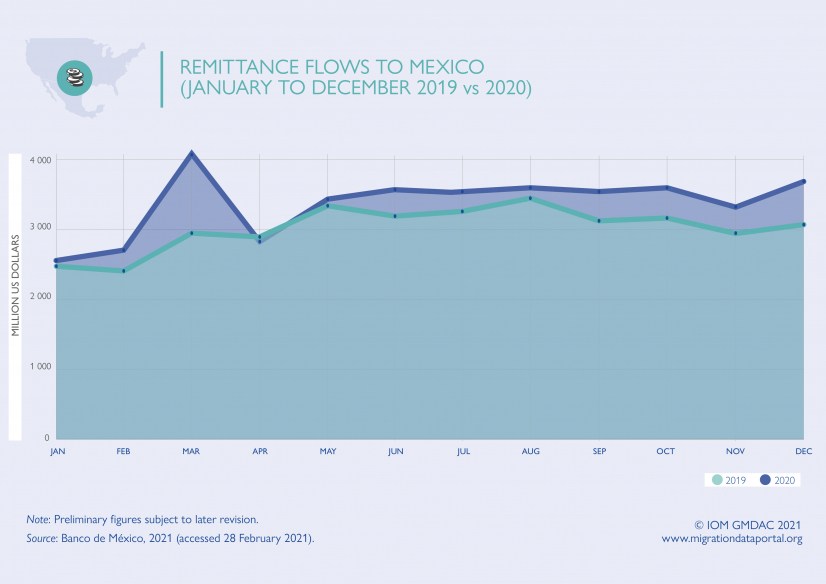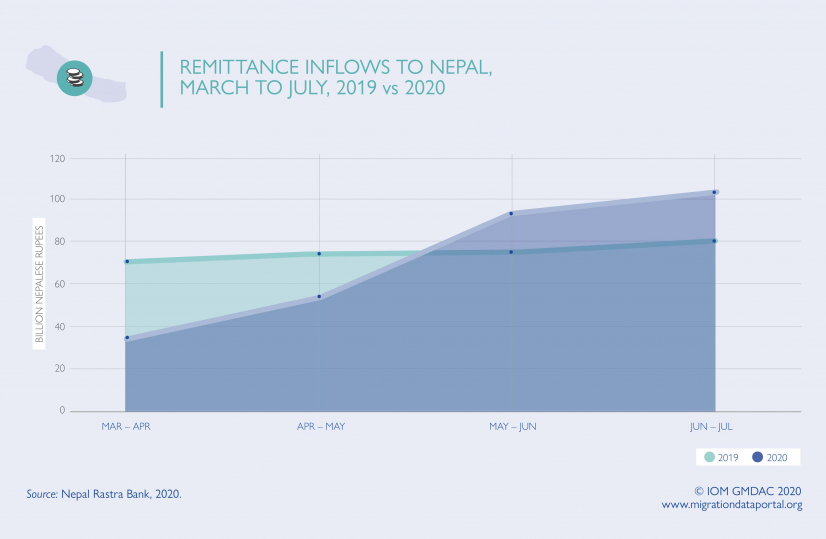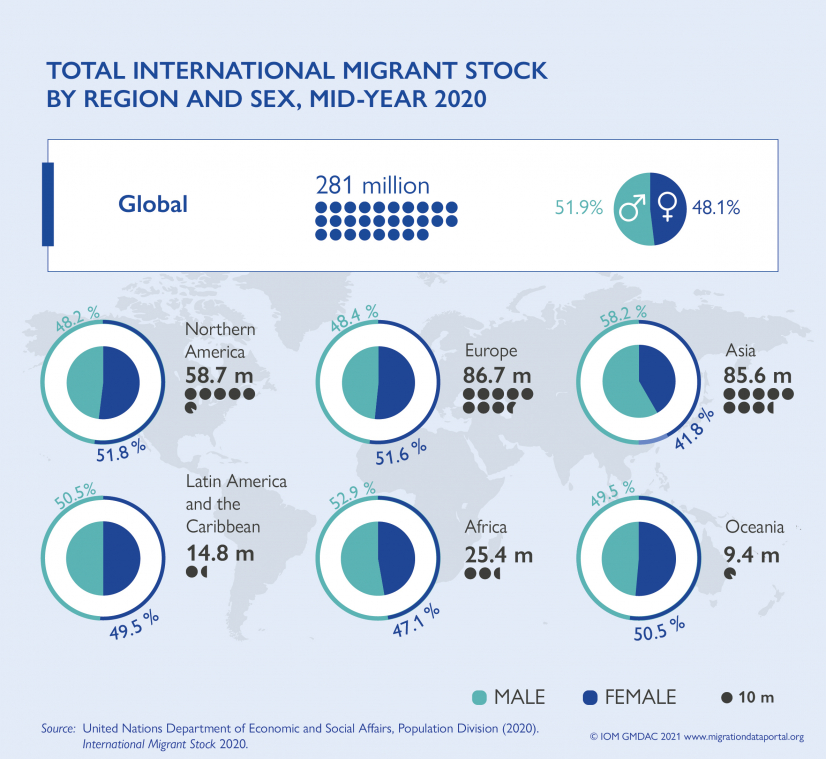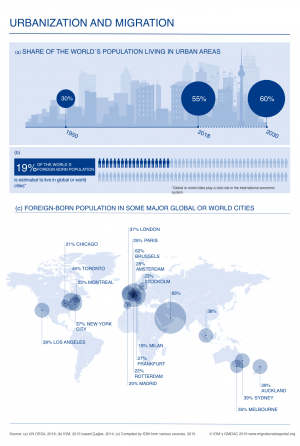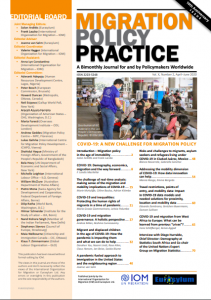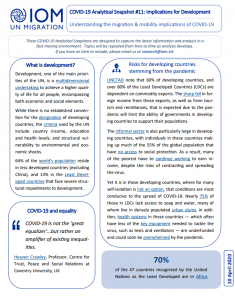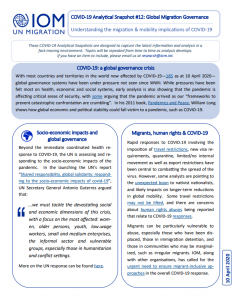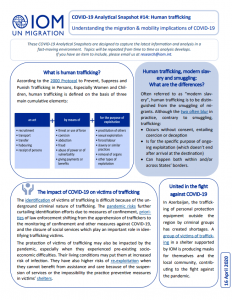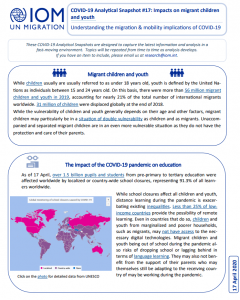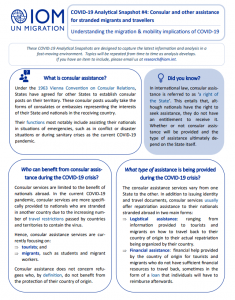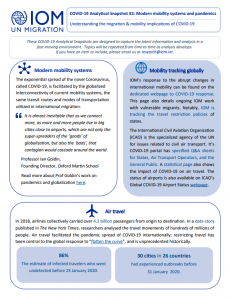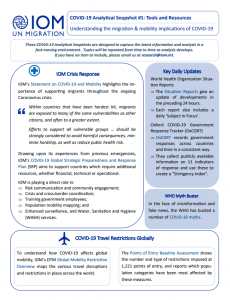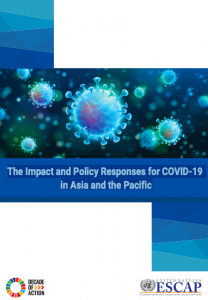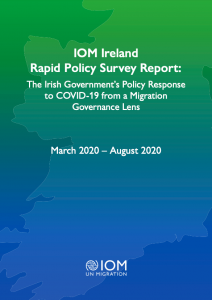Migration data relevant for the COVID-19 pandemic
Migrants – particularly in lower paid jobs and in irregular situations – may be both more affected by and vulnerable to the spread of COVID-19, but migrants also play an important role in the response to COVID-19 by working in critical sectors. As of 8 March 2022, emigrants from the 20 countries with the highest number of COVID-19 cases accounted for 32 per cent of the total international migrant stock and they had sent an estimated 38 per cent of all remittances globally to their countries of origin in 2021 (GMDAC analysis based on UN DESA, 2020; World Bank 2021a; WHO, 2022)1. Immigrants accounted for at least 3.7 per cent of the population in 12 of the 20 countries with the highest number of COVID-19 cases, and this share is more than 8 per cent in 9 of these countries (GMDAC analysis based on UN DESA, 2020; WHO, 2022). Compared to the global share of international migrants making up 3.6 per cent of the total population, international migrants are overrepresented in these countries.
This page discusses data on migrants that can inform how they are potentially both affected by the impact of COVID-19 and are part of the response to the pandemic. As information related to the COVID-19 pandemic is constantly evolving, figures and other data will be updated on a regular basis. For information by country, please see here and below the map for key indicators on migration and demography. For key trends by region on the impact of COVID-19, please see our regional data overviews.
Key migration trends
By theme
Changes in flows and migrant stocks
COVID-related restrictions have an impact on the mobility of migrants and the role of humanitarian organizations. Between 10 March 2020, a day before the WHO declared COVID-19 a pandemic, and 28 February 2022, 122,823 movement restrictions were implemented around the world (IOM, 2021a). At the same time, 208 countries, territories or areas have issued 961 exceptions to these restrictions, thus enabling mobility (ibid.). Assuming zero-growth in the number of migrants between 1 March and 1 July 2020, estimates suggest a decrease of nearly 2 million international migrants compared to the initially expected increase between mid-2019 and mid-2020 (UN DESA, 2020).
In 2020, permanent migration inflows to OECD countries are estimated to have fallen by more than 30 per cent and 2020 was a historical low for migration to OECD countries since 2003 (OECD, 2021). Among all categories of permanent migration to OECD countries, partially available data show that family migration experienced the largest decline in 2020 by more than 35 per cent (ibid.).
Such a drop in migration inflows due to COVID-related restrictions can also have demographic effects on countries dependent on migration for population growth. For example, national data for 2020 suggest that the population of Germany did not grow for the first time in the last decade due to a decline in immigration (German Federal Statistics Office, 2021a). As of the end of 2020, the total number of foreign nationals in Germany had risen by 1.8 per cent, the lowest rate in the last decade (German Federal Statistics Office, 2021b). In Australia, higher migration outflows than inflows in 2020/2021 have led to the lowest population growth in more than a century (Australian Centre for Population, 2021).
International students have also been affected by mobility restrictions in both origin and destination countries. The number of first permits issued by OECD countries to international students dropped significantly in 2020 as a result of COVID-19. For example, the United States of America and the United Kingdom -- the most popular destination countries for international students -- issued 69 per cent and 40 per cent fewer first permits to students in 2020 respectively compared to 2019 (OECD, 2021).
Infection and death rates among migrants
Low-skilled labour migrants in crowded dormitories have been disproportionately affected by the pandemic. Examples from Saudi Arabia and Singapore, where the Ministries of Health have provided official data on the migration status of individuals who tested positive, show the differential exposure to the virus of the migrant population. According to the Saudi Ministry of Health, 75 per cent of all newly confirmed cases as of 7 May 2020 were among migrants. In Singapore, over 95 per cent of the confirmed cases by 19 June 2020 were among migrants, with over 93 per cent of the total cases being related to migrants’ dormitories (Singapore Ministry of Health, 2022). Despite a downward trend in the number of new cases, as of 5 July 2021, cases among residents of dormitories continued to account for more than 87 per cent of the cumulative number of cases in Singapore. However, due to the exponential rise in COVID cases among those not resident in dormitories since the third quarter of 2021, the share of cases in dormitories relative to the overall number of cases in Singapore dropped to 9.1 per cent (ibid.).

As international migrants are a highly heterogenous group, the effects on their health are also varied. A rapid systematic review of publications found that the incidence rates among migrants and forcibly displaced persons appear to be consistently higher than among non-migrant groups (Hintermeier et. al., 2020). However, all studies included in this review focused on migrant and forcibly displaced persons who were at a higher risk of becoming infected due to their living and working conditions (ibid.). Another review of peer-reviewed literature, national datasets and grey literature by Hayward et. al. (2020) also shows that migrants in high-income countries are at increased risk of infection and death due to COVID-19. In addition to migrants’ living and working conditions, the study also attributes this disproportionate representation of migrants to limited access to healthcare (ibid.) (see section on migration governance). Even though the incidence rates of COVID-19 are higher among migrants in several countries, comparing the data is also challenging due to national differences in demographics and data collection (Laczko, 2021).
Labour migration
169 million people were estimated to be migrant workers in 2019 (ILO, 2021). 24.2 per cent of all migrant workers globally were hosted in Northern, Southern and Western Europe, and another 22.1 per cent were hosted in Northern America. More than two in five migrant workers were hosted in these regions and were among the first to be affected by lay-offs and movement restrictions and lockdowns impacting livelihoods such as losing their businesses. As evidenced in the previous section, living conditions in crowded housing pose a particular risk to the spread of COVID-19 among migrant workers.
The unemployment rates of migrants increased significantly in more than 75 per cent of all OECD countries in 2020 (OECD, 2021). An analysis of monthly data from the US Census Bureau shows that, from May to July 2021, the drop in the number of employed immigrants was steeper than the number of employed US-born adults compared to the same period in 2019 (Capps et al., 2021). Although data on unemployment rates disaggregated by migratory status are not available at a nationally representative level, analysis of data collected by IOM’s Displacement Tracking Matrix (DTM) shows that the unemployment rates of Venezuelans in Brazil, Chile, Colombia, Ecuador and Peru were higher than the unemployment rates among the populations of the destination countries (Chaves-González et al., 2021).
Beyond unemployment, the share of immigrant workers living in poverty in OECD countries – despite being employed – was highest in Southern European countries and the United States in 2017/18. The in-work poverty rates in Spain and the United States in 2018 were 32.1 and 24.8 per cent respectively and it was 29.1 per cent in Italy in 2017 (OECD, 2019b). Such migrants were disproportionately affected during the peak of the COVID-19 crisis when unemployment rates of citizens increased but measures to mitigate the effects did not include migrants.
Migrants, regardless of where they work, make important contributions to address the pandemic but are also exposed to higher risks of contracting the virus. As an illustration, among the 20 countries with the highest number of COVID-19 cases as of 8 March 2022, available international data for 2015/16 show that at least 7 countries – the United States, France, the United Kingdom, Germany, Italy, Spain, and the Netherlands – depended on foreign-born workers in the critical sector of healthcare services (OECD, 2019). On the higher end, 33 per cent of doctors and 22 per cent of nurses in the United Kingdom in 2015/16 were foreign-born (ibid.).
At the same time, a shortage of health care workers has been present at the global level for many years, and the demand for skilled health personnel is likely exacerbated by the current pandemic. In particular, origin countries of skilled migrants are faced with shortages in the health sector, which is however not only attributable to the emigration of workers. In the United Kingdom and the United States, 29 per cent and 25 per cent of doctors were foreign-trained (OECD, 2020). In both the United States and United Kingdom, the majority of foreign-trained doctors in 2016 were educated in India and Pakistan. Additionally, many foreign-trained doctors in the United States studied in the Caribbean Islands, the Philippines, Mexico and Canada while many practicing in the United Kingdom studied in Nigeria, Egypt, Ireland, Greece and South Africa (OECD, 2019).
Migrants constitute a significant share among sectors that are critical as well as sectors that are most affected by the crisis: For example, in 7 of the 20 countries with the highest number of COVID-19 cases as of 8 March 2022, more than 10 per cent of all services and sales workers were foreign-born. Additionally, available data show that more than 9 per cent of all skilled agricultural, forestry and fishery workers in 5 of these countries were foreign-born (GMDAC analysis based on OECD DIOC, 2015/16). On average, 13 per cent of all key workers in the European Union (EU) are immigrants (Fasani and Mazza, 2020). In 2017, the United States had recruited 161,583 foreign workers on seasonal work permits (OECD, 2019) and seasonal workers in countries in the EU are often undercounted. An estimated 69 per cent of all migrants in the United States work in critical infrastructure sectors (Center for Migration Studies, 2020 based on 2018 US Census Bureau data). In most of the OECD countries highly affected by the crisis, women make up between approximately three and five out of seven of the foreign-born workers in the services and sales sectors (GMDAC analysis based on OECD DIOC, 2015/16). The lockdowns in many countries can have disproportionate implications on the socioeconomic status of migrant women, who are overrepresented in these sectors among all migrant workers.
|
Country |
% foreign-born workers among all services and sales workers, 2015/16 |
% women among foreign-born services and sales workers, 2015/16 |
% foreign-born workers among skilled agricultural, forestry and fishery workers, 2015/16 |
% women among foreign-born skilled agricultural, forestry and fishery workers, 2015/16 |
|
United States of Americaa |
23.3 |
78.8 |
46.3 |
27.2 |
|
Spain |
19.5 |
58.9 |
11.3 |
5.3 |
|
Italy |
19.0 |
72.3 |
11.0 |
16.8 |
|
Germany |
18.4 |
58.8 |
9.6 |
11.7 |
|
France |
13.8 |
59.5 |
6.7 |
26.1 |
|
United Kingdomb |
13.8 |
11.0 |
16.8 |
78.5 |
|
Netherlands |
10.5 |
60.9 |
3.2 |
1.4 |
|
Polandb |
0.9 |
42.2 |
0.4 |
52.3 |
|
Mexicob |
0.6 |
41.5 |
0.3 |
11.3 |
Source: GMDAC analysis based on OECD DIOC, 2015/16
a Occupational data for the US are coded with US SOC codes and therefore are not directly comparable with data for the other countries in the above table which are coded with ISCO-08 codes.
b Since data are disaggregated by foreign-born, native-born and unknown, the percentages reflected here might be underestimates.
There were an estimated 11.5 million migrant domestic workers (MDWs) around the world in 2013, approximately 8.5 million of whom were female (ILO, 2015). In times of COVID 19, their employers may be infected and pass the disease on, perish with the worker losing their income since work permits are often tied to the employer. With border closures and economic constraints, returning to countries of origin is often not possible, trapping migrant domestic workers in destination countries without housing and income (see section on data disaggregated by sex below).
Remittances
An estimated 38 per cent of total remittance inflows globally in 2020 as well as in 2021 were received in the 20 countries with the highest number of confirmed COVID-19 cases as of 8 March 2022 (GMDAC analysis based on World Bank, 2021). Globally, 10 of the 20 countries with the highest number of COVID-19 cases – the United States of America, Germany, the Russian Federation, France, the Netherlands, Italy, the United Kingdom, the Republic of Korea, Japan and Poland – were among the 20 countries from which the highest amounts of remittances were sent in 2020. Remittances sent from these ten countries alone made up more than 28 per cent of all global remittances received in 2020 (ibid.).
Before the COVID-19 crisis started, the World Bank (2019) had projected that 574 billion USD will be sent to low- and middle-income countries by the end of 2020, but job losses and difficulty to send remittances during shutdowns will significantly affect recipients dependent on these remittances for their financial stability. In April 2020, Ratha et al. (2020a) estimated that remittances to low- and middle- income countries (LMICs) will fall to 445 billion USD in 2020, a decline of 20 per cent compared to 2019. In October 2020, Ratha et al. (2020b) adjusted their forecasted decline to LMICs to 508 billion USD in 2020 and a further decline to 470 billion USD in 2021. However, the latest data show that remittance flows to LMICs fell by only 1.7 per cent to USD 549 billion, defying projected declines that would have been the sharpest in recent history (Ratha et. al, 2021). Annual projections for 2021 expect remittance flows to LMICs to recover and increase by 7.3 per cent to USD 589 billion (ibid.).
Oil-producing countries in the Gulf Cooperation Council (GCC) are an important destination for migrants from South Asia and East Africa. As many international migrant workers in the GCC states returned to their origin countries (see section on return migration below), sending remittances to their families is no longer possible. Since one in nine people around the world depend on remittances sent by migrant workers, COVID-19 impacts migrant families and communities in terms of remittance-supported nutrition, health, education and income, which in turn may lead to potential setbacks on progress made on several of the UN SDGs. It should however be noted that remittances are private funds and cannot replace Official Development Assistance and other public spending.
Data from countries that are major recipients of remittances highlight the nuanced trend behind these variations. After an initial dip in the first half of 2020 (mostly in March and April), remittances appear to have rebounded to pre-COVID-19 rates and historical highs in several countries. For example, Pakistan – where remittance inflows accounted for nearly 8 per cent of the GDP in 2019 – saw the highest amount of monthly remittances historically in July 2020 (State Bank of Pakistan, 2020). In countries such as Mexico and Nepal, monthly remittances in the second, third and fourth quarters of 2020 increased to amounts higher than the previous year for the same period.
Several factors could be behind this trend: currency fluctuations paired with the effect of countries coming out of strict lockdowns – during which time usual household spending was limited and savings were higher – may have played an important role in the dip and rebound. Emerging economies faced sharp currency depreciation in February-March 2020 whereas the currencies of advanced economies were generally strong during the same period. This may have led to the usual amount of remittances sent getting converted to higher amounts in the receiving countries. The financial behaviour of migrants in times of crises could also be a factor, with migrants sending lockdown savings to support their families in countries heavily affected by the COVID-19 outbreak, but also vice versa, with families supporting migrants in countries affected. Additionally, migrants who returned to their countries of origin may also have transferred their savings through official channels before returning.
Stranded Migrants and Return Migration
Due to the travel restrictions and border closures imposed by governments globally, several migrants – including seasonal workers and international students – were stranded and unable to return to their countries of origin. As of 13 July 2020, IOM’s Return Task Force had identified at least 3 million stranded migrants (IOM, 2020). Of these, more than 1.2 million migrants were stranded in the IOM region of Middle East and North Africa (ibid.).
With migrants losing jobs and facing higher risks of being infected due to their often overcrowded living conditions, many workers are returning to their countries of origin, often with the help of bilateral negotiations that allow borders to be temporarily opened to return stranded migrants. Globally, India is the country of origin with the largest number of emigrants (UN DESA, 2020) and as of 30 April 2021, India’s official repatriation operation had facilitated the return of nearly 6.1 million stranded Indians from around the world (Indian Ministry of External Affairs, 2021). Nearly 1.6 million undocumented Afghans returned from Iran and Pakistan between 1 March 2020 and 19 August 2021. Of these, 117,145 Afghans had returned in the first two weeks of March 2020 alone (IOM, 2021d). As of 30 October 2020, more than 136,000 Venezuelan migrants and refugees had returned to Venezuela from other countries in the region (IOM and UN OCHA, 2020). At its peak, 600 Venezuelans returned from Colombia daily and an average of 88 Venezuelans returned from Brazil daily via the border at Pacaraima (Coordination Platform for Refugees and Migrants from Venezuela, 2020). Between 1 April 2020 and 26 March 2021, IOM had assisted more than 62,000 migrants who were in quarantine facilities after returning to Ethiopia from neighbouring African countries and Saudi Arabia (IOM, 2021e). Additionally, through the COVID-19 Return Task Force, IOM had assisted 1,100 migrants to return to their countries of origin in 2020 (IOM, 2021f).
Data collected by IOM’s DTM between 13 March 2020 and 7 March 2022 show that internal mobility restrictions in countries around the world had an impact on regular travellers and nationals in 60 per cent and 61 per cent respectively of the internal transit points assessed (2021g). Among 33,393 respondents of a study by the Mixed Migration Centre (2021), nearly 28 per cent reported that the pandemic had made it difficult to cross borders and another 25 per cent reported that it had affected internal mobility. With lockdowns leaving internal migrants unemployed and homeless, thousands of workers in the informal sector returned from cities such as New Delhi, India, to their hometowns (UN, 2020).
Such exoduses of migrant workers – both international and internal migrants – have two main effects on the countries and places of origin: increased health vulnerabilities (Zenner and Wickramage, 2020) and socioeconomic pressure. In addition to the direct economic effects of lost remittances (see section above), studies show that international remittances from migrants to their families reduce child labour and keep children at school (ILO-UNICEF, 2020). With the projected loss of USD 109 billion in remittances due to COVID-19, more children are at risk of being forced into child labour.
Conversely, return migration also affects the former countries of destination that are dependent on migrant workers in essential sectors (see section on labour migration). Migrants made up an estimated19 per cent of the population in Germany, 15 per cent in the United States of America and Spain, 14 per cent in the Netherlands and the United Kingdom, and 13 per cent in France at mid-year 2020 (all among the top 20 countries with the highest number of COVID-19 cumulative cases, as of 8 March 2022) (UN DESA, 2020), where they are also overrepresented in essential sectors such as healthcare and services.
Urbanization
Approximately one in five international migrants were estimated to live in just 20 cities - Beijing, Berlin, Brussels, Buenos Aires, Chicago, Hong Kong SAR, China, London, Los Angeles, Madrid, Moscow, New York, Paris, Seoul, Shanghai, Singapore, Sydney, Tokyo, Toronto, Vienna and Washington DC (IOM, 2015). In 18 of these cities, international migrants represented around 20 per cent of the total population (ibid.). The share of foreign-born persons in the total population in some cities exceeds the global average (around 3.4% in 2015) by a large margin (IOM, 2015). Dubai had a foreign born population of close to 83 per cent, while in Brussels it is 62 per cent, in Toronto 46 per cent and Melbourne 35 per cent, to name a few examples (ibid.).
Income inequality and marginalization affect local patterns of COVID-19 prevalence. For instance, while positive cases have been recorded throughout New York, most confirmed cases were in areas with the lowest median incomes, despite the limited local availability of testing. This is likely due to structural factors linked to living and working conditions preventing people from applying basic prevention and mitigation measures. More than 35 per cent of the population in New York in 2018 were foreign-born and publicly available data from the New York City Department of Health and Mental Hygiene show that migrants were overrepresented in all but 1 of the 10 areas most affected by COVID-19 in the city (in terms of positive cases per 1000 residents).
Forced migration or displacement
COVID-19 and related global movement restrictions have also affected displaced persons UNHCR’s estimation model compared to their forecasts shows that approximately 1.5 million fewer refugees and asylum-seekers arrived in 2020 than would have been expected without COVID-19 (2021). Globally, the number of new asylum applications lodged in the first half of 2020 was 32 per cent less than the number during the same period in 2019 (OECD et. al., 2020). In OECD countries, the drop in number of new asylum applications was 31 per cent in 2020 compared to 2019 (OECD, 2021). The European Union saw a nearly 34 per cent decrease in first-time asylum applications in 2020 compared to the same period in 2019 (Eurostat, 2021a). However, the number of first-time asylum applications had increased by 48 per cent and 38 per cent in the second and third quarters of 2021 respectively compared to the same time period in 2020 (Eurostat, 2021b).
The 20 countries with the highest number of confirmed COVID-19 cases as of 8 March 2022 hosted about 7.4 million refugees, or more than 35 per cent of refugees worldwide by mid-year 2021(GMDAC analysis based on WHO, 2022 and UNHCR, 2021a). Of these 20 countries, Turkey, Germany, the Islamic Republic of Iran, France, and the US were among the top 20 refugee-hosting countries according to data by UNHCR as of mid-year 2021. Additionally, the United States of America, Turkey, Germany, Brazil, Mexico, Spain and the United Kingdom were among the 10 countries with the highest number of pending asylum applications as of mid-year 2021 (ibid.). Despite the 1 million drop in asylum claims globally, nearly 21,000 unaccompanied or separated children had applied for asylum in 2020 (UNHCR, 2021b). As of 31 December 2020, more than 270,000 Venezuelans had pending asylum claims in the US, Brazil, Colombia, Spain, Mexico and Argentina (ibid.).
Migrant deaths and disappearances
Despite the mobility constraints posed by the COVID-19 pandemic, migrants continue to embark on clandestine journeys, fleeing violence and poverty and seeking to improve their lives. COVID-19 responses have increased the risks and uncertainty of these journeys, pushing people into more perilous situations where humanitarian support and rescue may not be available. IOM’s Missing Migrants Project (MMP) recorded 5,895 deaths on migratory routes worldwide in 2021, surpassing pre-pandemic figures and making last year the deadliest year on record for migrants since 2017. Not included in this total are the thousands of deaths linked to COVID-19 cases among migrant workers and deaths related to mobility restrictions and lockdowns.
Amidst the pandemic, at least 3,411 people lost their lives attempting to reach Europe on maritime and land routes in 2021. The Central Mediterranean has remained the deadliest known irregular migration corridor worldwide. In 2021, at least 1,553 people, including 116 women and 48 minors lost their lives on this route. More fatalities were recorded on this route in 2021 than in any year since 2017. COVID-19 related measures continue to impact search and rescue efforts, with new imposed restrictions on the operations of civilian (NGO-run) vessels and denying or delaying disembarkation at safe ports in multiple instances.
Meanwhile, conflict and poverty exacerbated by measures to counter the COVID-19 pandemic, have compelled increasing numbers of people to embark on the extremely perilous journeys on the Western African Atlantic route from the coast of Senegal, Mauritania and Morocco to Spain’s Canary Islands. Since September 2020, there has been an increase in documented arrivals to Spain from this route. In 2021, nearly 1,109 deaths were recorded, including those of 270 women and almost 100 minors, making it the year with the most recorded fatalities since IOM began collecting data in 2014. Yet, according to NGO reports and many unverified cases of disappearances at sea, this figure is likely a significant undercount of the real number of lives lost on this route.
The impact of the COVID-19 pandemic on economies in the Americas pushed more people seeking safety, family reunification, decent work, dignity, and better opportunities to take dangerous migration routes. At least 717 men, women and children lost their lives on the United States-Mexico border, making it the deadliest year for migrants since IOM started recording migrant deaths. Additionally, 100 fatalities were recorded on maritime routes to the US. In the Darien Gap, the number of fatalities increased almost tenfold in 2021, with 51 recorded deaths.
In 2021, deaths on migration routes around the world approached pre-pandemic levels and, in many cases, even surpassed them. Missing Migrants Project data show that while societies rebuild in the wake of the COVID-19 pandemic, people looking for safety and better opportunities have little option but to embark on dangerous journeys.
By age
The UN Sustainable Development Goals call for ensuring that no one is left behind, including migrants. Different age groups face varying vulnerabilities as both migrants and as part of a certain period in life. Globally, about 12 per cent of all international migrants are 65 years and older. However, in 13 of the 20 countries with the highest number of confirmed cases as of 8 March 2022, persons aged 65 years and older represent a lower share in the international migrant stock compared to their share in the general population. India, Brazil, France, the Russian Federation, Argentina, Poland and Ukraine are the countries where this is an exception. In 15 of the 20 countries with the highest number of confirmed cases, between 67 per cent and 84 per cent of migrants are estimated to be of working age (between 20 and 64 years old) (GMDAC analysis based on WHO, 2022 and UN DESA, 2020). Migrants are thus more likely to be either young or of working age and are part of the response by working in critical sectors. They are also at risk of being exposed to COVID-19 by working in sectors where home-based work is not possible (see section on labour migration for detailed analysis).
Migrants in countries with the highest number of cumulative COVID-19 cases, as of 8 March 2022
|
Country |
Share of migrants in total population (%), mid-2020 |
Share of working age migrants (20-64 years) in migrant stock (%), mid-2020 |
Share of persons 65 years and older in migrant stock (%), mid-2020 |
Share of persons 65 years and older in population (%), mid-2020 |
|
United States of America |
15.3 |
77.2 |
14.5 |
16.6 |
|
India |
0.4 |
70.7 |
21.6 |
6.6 |
|
Brazil |
0.5 |
59.3 |
15.7 |
9.6 |
|
France |
13.1 |
67.6 |
22.6 |
20.8 |
|
United Kingdom |
13.8 |
77.4 |
11.0 |
18.7 |
|
Russian Federation |
8.0 |
76.7 |
16.9 |
15.5 |
|
Germany |
18.8 |
70.2 |
21.4 |
21.7 |
|
Turkey |
7.2 |
70.9 |
5.9 |
9.0 |
|
Italy |
10.6 |
84.4 |
7.1 |
23.3 |
|
Spain |
14.6 |
80.7 |
9.0 |
20.0 |
|
Argentina |
5.0 |
68.4 |
14.2 |
11.4 |
|
Iran (Islamic Republic of) |
3.3 |
51.4 |
2.5 |
6.6 |
|
Netherlands |
13.8 |
77.2 |
12.8 |
20.0 |
|
Colombia |
3.7 |
57.6 |
2.6 |
9.1 |
|
Indonesia |
0.1 |
78.5 |
5.0 |
6.3 |
|
Poland |
2.2 |
36.9 |
40.8 |
18.7 |
|
Mexico |
0.9 |
34.8 |
4.5 |
7.6 |
|
Japan |
2.2 |
80.6 |
8.2 |
28.4 |
|
Ukraine |
11.4 |
72.9 |
20.3 |
16.9 |
|
Republic of Korea |
3.4 |
80.4 |
3.8 |
15.8 |
|
Global average |
3.6 |
73.2 |
12.2 |
10.0 |
Source: GMDAC analysis based on WHO, 2022 and UN DESA, 2020
By sex
Women comprised less than half, 135 million or 48.1 per cent, of the global international migrant stock at mid-year 2020 (UN DESA, 2020). However, more female migrants are migrating independently for work, education and as heads of households. Despite these advances, female migrants may still face stronger discrimination, and are more vulnerable to mistreatment compared to male migrants. In general, the pandemic has led to an increase in gender-based violence (CARE and IRC, 2020).
Nonetheless, men are also exposed to vulnerabilities in the migration processes. Therefore, gender-responsive data on migration have potential to promote greater equality and are key to avoid exacerbated repercussions for disadvantaged groups. Care work also disproportionally rests on women, including caring for those affected by COVID-19 and children in light of day-care and school closures (ibid.). As healthcare workers, female migrants may face an additional burden to their job by having to care for family members at home and at the same time potentially facing stigmatization if in contact with patients infected with COVID-19.
The larger presence of men in the international migrant stock is also reflected in the proportion of male migrant workers. In 2019, migrant workers were estimated to be 58.5 per cent male and 41.5 per cent female (ILO, 2021). At 59.8 per cent and 46.7 per cent respectively, the labour force participation rate of migrant women was higher than that of non-migrant women in 2019 (ibid.). In the current global health crisis, female migrant workers may thus be more affected by unemployment than female nationals, and can therefore experience double discrimination as both migrants and as women in their host country.
Migration Governance
Access to healthcare
An analysis of Migration Governance Indicators (MGI) assessments conducted between 2018 and 2021 in 84 countries found that these countries provide migrants with varying degrees of access to government-funded health services depending on their migratory status. The analysis showed that a third of these countries provide the same access to health care to both citizens and migrants, regardless of their migratory status. In half of the countries surveyed, equal access to health care is contingent on migratory status. Moreover, 12 per cent of the countries provide migrants with access to some health services only, including emergency health care. In most cases, there are no limitations to access to private health care or insurance.
Analysis of migration-related data from the United Nations Twelfth Inquiry among Governments on Population and Development - another effort to collect data on SDG target 10.7.2 - also shows that migrants' access to health services can depend on migratory status. The Inquiry, which collected data on 111 countries between late 2018 and early 2019, found that more than three quarters (86 per cent) of governments provide essential and emergency health care to all non-nationals, regardless of their migratory status, while 8 per cent indicate that they provide such services only to those whose status is regular.
Inclusion of migrants in crisis plans
COVID-19 affects all regardless of nationality, but migrants are often left out in national pandemic plans due to a lack of data disaggregation by migratory status. A review of pandemic influenza preparedness plans in 21 countries of the Asia Pacific region in 2016 only found 3 countries (Thailand, Papua New Guinea and the Maldives) adequately included non-citizens beyond health control measures at borders (18 out of 21 countries, Wickramage et al., 2018). Excluding migrants’ access to entitlements or access to health care in domestic legal and policy frameworks may increase transmission risks, adverse outcomes and inhibit access to early detection, treatment and negatively affect public health management (Zenner and Wickramage, 2020).
Most MGI countries do not have a strategy with specific measures to assist migrants before, during, and post-crisis phases. MGI assessment data from 84 countries indicates that there are no such strategies in 65 per cent (55 countries) of the MGI countries assessed. These measures mainly pertain to internal displacement, refugee movements and humanitarian assistance on an equal footing to nationals and migrants. Measures on maintaining or upscaling health systems during a public health crisis are not specifically mentioned. Nineteen per cent of the countries partially include these types of measures in the sense that their strategies are inclusive of all vulnerable communities (thus informally encompassing migrants). Some countries temporarily relax immigration requirements, allowing migrants whose country of origin has been affected by a crisis to remain in the destination country beyond the usual time limit. In other cases, assistance is provided de facto to all migrants irrespective of their migration status. Only 15 per cent of the countries assessed have specific measures to assist migrants, but several mention that assistance is given on an ad hoc basis.
Conversely, 60 per cent of the countries offer assistance to their nationals abroad in times of crisis. Most of these countries provide emergency travel documents and repatriation possibilities, but only for broadly defined “humanitarian crises”. 38 per cent of the countries that participated in the MGI assessment offer assistance on a case-by-case basis and only where a migrant’s country of origin is represented through consular bodies. In most cases, assistance from the country of origin is limited or even not possible when there are no consulates in the receiving country.
In 2 per cent of the assessed MGI countries, there are no specific measures to assist nationals living abroad in times of crisis. Similar to the MGI assessments, the UN Inquiry found that 68 per cent of governments have specific measures to provide assistance to citizens residing abroad in countries in crisis or post-crisis situations.
Ireland carried out a rapid policy survey based on the MGI COVID-19 module in May 2020 to assess the extent to which COVID-19 response policies - whether it be migration, crisis response, health, socioeconomic recovery or other policies - recognize and address the special needs and vulnerabilities of migrants in the country as well as nationals abroad and promote their contributions to the COVID-19 response and the country’s economy. The report highlights access to COVID-19 public medical testing and treatment for all people residing in Ireland, irrespective of their migratory status, among other key findings.
Inclusion of migrants in COVID-19 vaccination campaigns
Though some countries report including migrants in their official National Deployment and Vaccination Plans (NDVPs), IOM has observed that these plans are not always enacted in practice. As of 17 May 2021, 33 per cent of 152 countries reported including irregular migrants in their NDVPs whereas only 28 per cent of the observed 168 countries actually included them in practice. Similarly, 56 per cent of 152 countries reported including refugees and asylum seekers in their NDVPs whereas only 45 per cent of the observed 168 countries actually included them in the roll-out of those campaigns on the ground (IOM, 2021b). Despite a continued lack of clarity on NDVPs regarding migrants’ access to vaccines, more recent data as of 8 December 2021 show that, in practice, 83 per cent of the observed 180 countries provided vaccine access to regular migrants, but only 46 per cent provided access to migrants in irregular situations and slightly more than 73 per cent provided access to refugees and asylum-seekers (IOM, 2021c).
Back to topData strengths & limitations
For detailed analyses of the strengths and limitations of the highlighted data sources, please visit the thematic pages on:
- International migrant stocks and flows
- Migration and health data
- Labour migration
- Remittances
- Family migration
- International students
- Urbanization
- Return and Migration
- Forced migration or displacement
- Environmental migration
- Migration policies and governance
For the detailed methodology on IOM’s mobility restrictions tracking, please visit https://migration.iom.int/
1 The figures on new cases face inconsistencies across countries and may underreport the real extent of case data as official figures are based on tested cases only and as such capacities to test and testing itself varies by country. The same applies to recorded deaths caused by COVID-19 as different criteria for counting deaths as COVID-19 related/based or not are used in different countries.
Back to top



